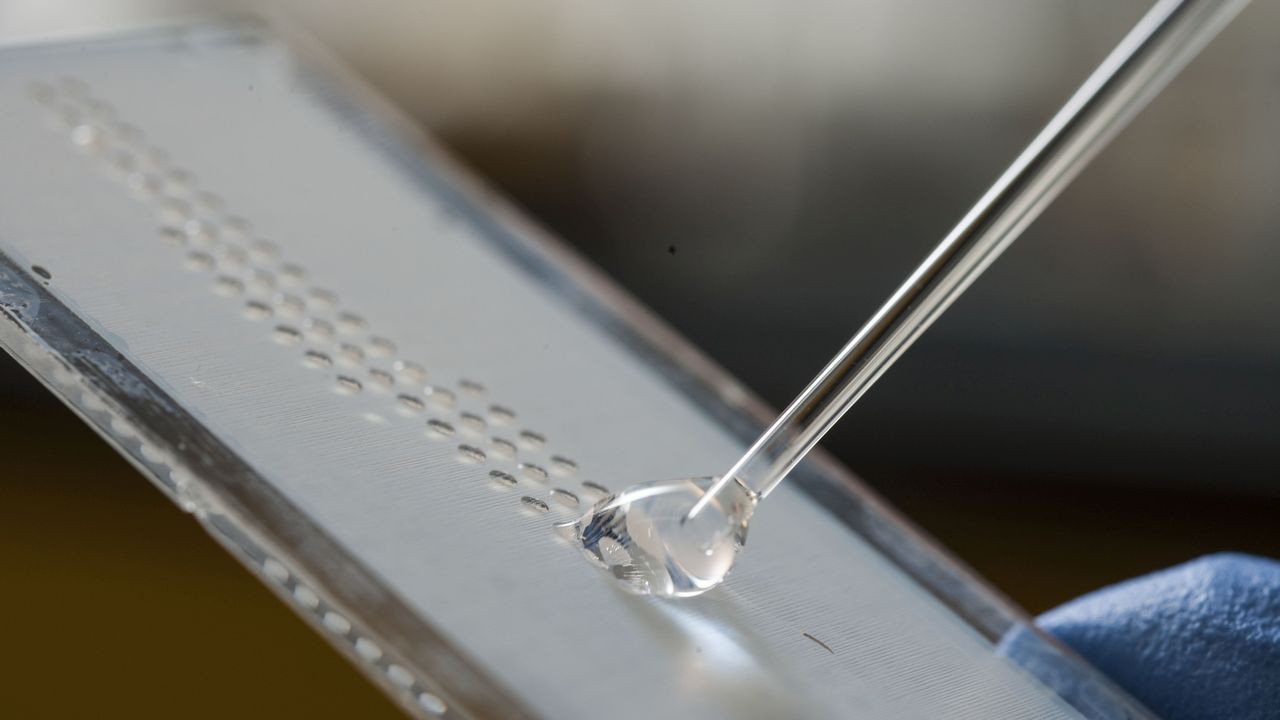Modern laboratory technology cannot only help develop new medicine, but also make quicker diagnoses of higher precision. Scientists of Karlsruhe Institute of Technology (KIT) have now developed laboratory equipment that facilitates the search for active substances and the examination of cell samples. Thus, costs are reduced by a factor of up to one hundred.
Treatment methods can be adapted better to the individual needs of patients. The scientists of KIT have found a way to execute so-called high-throughput screenings with thousands of samples being tested in parallel without any expensive and complex robot systems that have been necessary so far.
Chemist Pavel Levkin of KIT’s Institute of Toxicology and Genetics (ITG) and his multidisciplinary team have developed a surface on which aqueous solutions self-arrange in thousands of separate droplets. “On a droplet microarray (DMA), biological samples, such as tissue from a biopsy, can be subjected to substance screening,” Levkin’s team member Simon Widmaier, ITG, says. Every individual droplet is used as a type of test tube for biological experiments. Pipetting robots and pipette tips that have been indispensable so far are no longer required. “An individual laboratory employee can execute thousands of substance screening experiments within a few seconds.” The cost reduction potential of this new technology is enormous according to Widmaier. “A pipetting robot costs several 10,000 Euros and has to be operated by an expert.” Each pipetting step alone costs five to seven cents for a pipette tip.
By means of a highly precise UV exposure method, highly water-attracting and highly water-repellent areas are produced on the array surface. As a result, the size of the droplets to be investigated can be varied between three and 250 nanoliters (one nanoliter corresponds to one billionth of a liter). When using conventional microtiter plates with lines and rows of depressions, 40 microliters (one microliter corresponds to one millionth of a liter) of reactants at least are required. “Estimated roughly, a DMA consumes a thousand times less reactants. As these substances often are very expensive - some are more expensive than gold - this is a big advantage for users,” Widmaier says.
Moreover, classical pipetting technology does not allow for portioning fluids with finely dispersed solids, e.g. cells, in nanoliter amounts. On the novel biologically compatible polymer, by contrast, experiments can also be performed with a few living cells. The technology has big advantages when screening stem and primary cells for the effect of substances on human organs. Widmaier expects that screening results will be more reliable and development of medicine will be much cheaper in the future.
To commercialize their findings, the researchers plan to establish the company Aquarray. In this way, they want to enable biological research laboratories with small funds to perform high-throughput screenings. They also want to make it easier for diagnostic laboratories to perform personalized substance screenings for e.g. cancer treatment. Last, but not least, costs of large pharmaceutical companies will be reduced. “The DMA technology solves the central problem of miniaturization of cell experiments and allows for screenings of medical substances and smallest cell volumes, an example being biopsy tissues of patients. We want to develop, produce, and commercialize droplet microarrays, product platforms, and screening kits and offer them to research institutes, screening centers, and pharmaceutical companies for cell-based substance screening in the context of personalized medicine,” Widmayer says. First prototypes are being tested on the market.
Being “The Research University in the Helmholtz Association”, KIT creates and imparts knowledge for the society and the environment. It is the objective to make significant contributions to the global challenges in the fields of energy, mobility, and information. For this, about 10,000 employees cooperate in a broad range of disciplines in natural sciences, engineering sciences, economics, and the humanities and social sciences. KIT prepares its 22,800 students for responsible tasks in society, industry, and science by offering research-based study programs. Innovation efforts at KIT build a bridge between important scientific findings and their application for the benefit of society, economic prosperity, and the preservation of our natural basis of life. KIT is one of the German universities of excellence.

